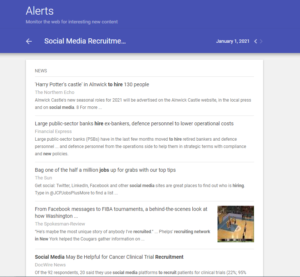Blog
How To Create a Social Media Recruitment Strategy
- January 13, 2021
- Posted by: Ishani Singh
- Category: Recruitment

Recruiting through social media stands out in the cloud of various types of recruiting because it allows a recruiter to find and connect with not just active, but also passive jobseekers. But you need a Social Media Recruitment Strategy first.
It gives you a chance to engage with the passive candidates through shared interest – posts, blogs, videos – something that you can not do in other recruitment methods. This enables you to identify, attract, and engage the candidates before you hire them.
You can leverage social media to hire better, but only if you have a well-thought strategy to engage the crowd, building relationships, and spending time and effort where your target audience is.
Failing to plan is planning to fail.
A good social media recruitment strategy will help you build a strong online presence. You’ll be able to plan and schedule your posts, but more on that later. And having a strategy for your social media activities will ensure that your posts stay relevant to the target audience. It’ll also ensure that you don’t fail to maintain consistency and I can’t stress it enough how important that is.
Go through these 5 strategies and assess the pros and cons to down-select the right strategy for you. Do consider your budget and manpower available before deciding.
- Work on Employer Branding or Recruiter Branding
- Pick your Social Media Platforms
- Share high quality and varied content
- Leverage hashtags
- Utilize in-built insights to ensure better gains
Work on Employer or Recruiter Branding
In a time when the internet is filled with options for candidates, you need to work on building your brand. You need to gain authority in your field and show that you’re credible.
Share content that highlights your company’s strengths. This way you’ll be able to organically attract candidates. Show why yours is a great place to work – the work culture, the benefits – anything that helps put you on the pedestal.
You can work towards building your recruiter brand too. If you can convince candidates that you’re reliable, even before you’ve contacted them, they might want to work with you. That will be good for business, right?
Don’t forget to be consistent. This is important. You can use Social Media Management Tools such as Zoho Social and it’ll save you time and help you improve your reach by identifying the optimal time of the day.
Pick your Social Media Platforms
Because you have to be consistent on social media to build your brand, trying to be present on all the platforms might not be a good idea for your business.
The first step in choosing a platform is to know who your target audiences are and where they tend to go. Social Media Demographics may help you determine which platform would be good for business.
 Facebook is most popular among middle-aged adults, for people of all educational backgrounds and income levels. It is considered a good platform for small businesses. It allows you to fine-tune your target audience and can help you earn big bucks if you’re consistent with clever posts.
Facebook is most popular among middle-aged adults, for people of all educational backgrounds and income levels. It is considered a good platform for small businesses. It allows you to fine-tune your target audience and can help you earn big bucks if you’re consistent with clever posts.
 LinkedIn, being a business-focused site, can be very useful to position yourself or the company as an expert in your industry. It is a great platform, especially if you’re targeting senior-level influencers and people with decision making power in a company. LinkedIn is very good for sales prospects and lead generation. And B2B companies would likely benefit from using LinkedIn.
LinkedIn, being a business-focused site, can be very useful to position yourself or the company as an expert in your industry. It is a great platform, especially if you’re targeting senior-level influencers and people with decision making power in a company. LinkedIn is very good for sales prospects and lead generation. And B2B companies would likely benefit from using LinkedIn.
 Twitter is more used by younger peeps – 18 to 29 in general. It is more popular with highly educated people living in urban areas. Twitter is greatly used by celebrities, journalists, and politicians.
Twitter is more used by younger peeps – 18 to 29 in general. It is more popular with highly educated people living in urban areas. Twitter is greatly used by celebrities, journalists, and politicians.
 Instagram is becoming a near-essential element for younger generations. It is most popular among 18-29 age groups – most of them visiting Instagram daily. Moreover, it is mostly accessed by mobiles. It is a photo and video sharing platform and is very good for branding. Using the right hashtags will get really far on Instagram.
Instagram is becoming a near-essential element for younger generations. It is most popular among 18-29 age groups – most of them visiting Instagram daily. Moreover, it is mostly accessed by mobiles. It is a photo and video sharing platform and is very good for branding. Using the right hashtags will get really far on Instagram.
Share high quality and varied content
You must have heard about the importance of creating quality content. But what really is quality content?
Quality Content is any content you create that helps in meeting one or more of the marketing objectives such as increasing brand awareness, improving click-through rates and engagement, or generating leads.
To create content that is original, interesting, and shareable, you need to ensure doing the following things.
- Research Good Content
- Research about that topic
- Share your own experiences, views, or opinions
- Use different content format
Research Good Content
Your content topics play a big role in determining whether your piece would be well received or forgettable. If you select something that your audience wants to read about, they will spread it out for you.
You can get a clear picture of what is in demand by looking at what works for other websites. You can use tools such as BuzzSumo to know what’s popular on sites you want to look at.
It helps to research to have a few content ideas and work on the piece as and when required. You could save the ideas for a later date on your editorial calendar.
Research about that topic
Researching the topic is a non-negotiable step of a social media recruitment strategy, even when you’re writing solely based on your experience. It is important whenever you’re creating content, irrespective of the format – visual, audio, or written.
 But be careful not to end up sounding just like the article you read while researching. You may avoid doing so by sharing your own views on the topic, even when they are different from what you’ve read.
But be careful not to end up sounding just like the article you read while researching. You may avoid doing so by sharing your own views on the topic, even when they are different from what you’ve read.
You can use Google Alerts to find studies or data that would help you seem more credible.
Share your own experiences, views, or opinions
If you have an experience or view to share on that topic, even if it contradicts popular opinion, use it. You can include it in your content either alone, or along with others’ similar experiences to form a pattern that supports your opinion.
Use different content format
Apart from focusing on quality, you also need to ensure a mix of content formats. Using multimedia can make your content more interesting. You may complement your written content with such media as
- Videos
- Infographics
- Pictures
- Screenshots
- Memes
Utilize in-built insights to ensure better gains
Social Media Analytics will show you what type of contents are driving more user acceptance for your pages. Once you are aware of what works for your social media accounts, you can focus more on that kind of content. This will allow you to see better results with the same amount of effort. You can improve the line of content this way. Platforms like Facebook, LinkedIn, and Instagram have in-built analytics that you can use free of cost.
To utilize the power of in-built insights for managing your social media efforts, you first need to understand what you want to measure and what your key metric is.
“You can’t manage what you can’t measure”
What you want to measure should relate to what you want to achieve.
- You may measure increasing followers if one of your goals is to improve your brand awareness.
- Measuring the number of likes and comments on posts can be useful if one of your goals is to boost brand engagement.
- You may measure the website clicks if your goal is to drive traffic to your website.
- Measuring the number of viewers converting to customers will help if you want to grow revenue.
Leverage hashtags

Hashtags are used to compile different posts about an event, person, thing, or emotion. They have become common among individuals and businesses to reach out to those with similar interests.
Hashtags can be used in different social media platforms by businesses to increase reach and engagement.
Using hashtags on Twitter gives a chance to increase your impressions and engagement. And since Twitter has a character limit of 280, you should ensure that the hashtag is meaningful to your message. You may post up to 2 hashtags for good performance.
Instagram doesn’t have a strict character limit and allows you to share as many as 30 hashtags in a post. Here hashtags are very helpful in interaction and engagement for your posts. The more you use, the better!
Unlike on Twitter and Instagram, the use of hashtags on Facebook may seem unnatural and forced. It gets tricky here. You don’t want to use a lot of hashtags, just 1-2, and that too only when it is relevant to your post or conversation.
Wrapping Up!
 Social Media is used by more and more recruiters to get more and better quality candidates. To be better and to stay relevant, you need to strategize, plan beforehand, and implement to maintain a consistent presence.
Social Media is used by more and more recruiters to get more and better quality candidates. To be better and to stay relevant, you need to strategize, plan beforehand, and implement to maintain a consistent presence.
If you’re still not convinced, think about it this way –
By using a well thought out social media recruitment strategy, you can reach out to and attract passive candidates. You can share about your company culture to find a good culture fit. It is a budget-friendly option to build a brand and recruit; more often than not it is free and you only need to invest your time.
Follow us on Facebook, LinkedIn, or Instagram to stay up to date!

Ishani works as Manager – Social Media & Strategy Big Ideas HR Consulting Pvt. Ltd. and also as a Freelance Digital Marketer. She has a knack for problem-solving and also enjoys writing. She loves to share her views and knowledge with the readers by the medium of her blogs.

I am pleased that I detected thhis web blog, just the right information that I
was searxhing for!
Also visit my blog post Ραδιοφωνικα σποτ
[…] a relatively cheap way to reach out to a large number of potential employees. But, a great deal of strategizing and planning is required to execute social recruitment […]
[…] Don’t worry, you’re not alone in this. We had written a brief ‘how-to’ guide on social media recruitment strategies. You can read it here. […]
[…] resume. This is important because according to a CareerBuilder Survey – 70% of employers use social media to screen candidates during the hiring process, and about 43% of employers use social media to […]